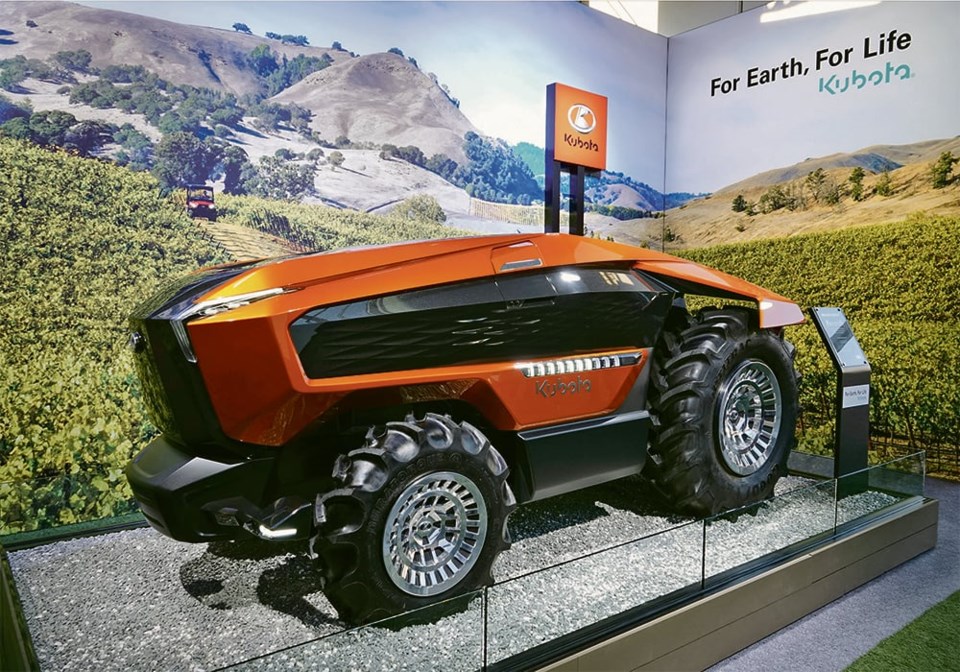WESTERN PRODUCER — In recent years, automotive and agricultural equipment brands have been increasingly looking to the Las Vegas Consumer Electronics Show to debut new digital and robotic technologies as those features proliferate on new machines.
This year Kubota chose that event to unveil its New Agri Concept fully autonomous tractor. Autonomous machines and data utilization are key elements in the brand’s Smart Agriculture long-term vision.
“It’s our first time at CES,” said Brett McMickell, senior technologist for Kubota North America, “so we wanted to get into the dialogue of technology and try to focus technology on the problems we’re really passionate about, and that’s solving problems in food, water and the environment. So we came to CES to introduce ourselves.
“We showed our vision of technology and how it can be used. In the booth we focused on a small vineyard owner and what the solutions could look like for that owner.”
The robotic tractor sat next to Google’s booth at the show.
The New Agri Concept tractor was built on a platform without an operator station, but McMickell said that could be just one version of what an autonomous production tractor from Kubota would look like.
“I think the future is going to hold mixed,” he said.
“There are certain operations where just having an autonomous robot out in the field is going to be sufficient. However, growers use tractors for a wide variety of tasks, so I don’t see us moving away from having a cab on at least some of them.
“Like an M5, I can envision having a cab and some autonomous features on it. But I can also envision 100 horsepower vehicles without a cab. So we wanted to lean forward and show what that future looks like without an operator.”
When it’s eventually released, the autonomous tractor will be tailored to meet the specific needs of growers where it is marketed. As a result, it could see several design changes and possibly more than one production version.
As an example of that, Kubota already has autonomous equipment on the commercial market in Asia, which do have operator stations.
“We’re releasing autonomous vehicles in the market that are suited for that market,” McMickell said.
“In Asia right now, for instance, there is an Agri Robo line. The first of those vehicles is the MR1000A. If you look at the MR1000A, which is out in customers’ hands now, it actually has a cab, where the New Agri Concept doesn’t. That’s because we heard from the (Asian) growers they wanted a utility vehicle that they can still drive around and use for other tasks. We automated the tasks they found less desirable. For those we can go fully autonomous or even remote control.
“As we define the problem we’re solving, we’re modifying the vehicle to meet that need. The sensor complements change, depending on how we’re releasing it. We’re not just putting technology out there, we want the technology to provide real value to customers. So we’re going to modify this depending on the specific customers we target and what their needs are.”
The New Agri Concept model displayed at CES is a fully battery-electric vehicle that uses six independent drive motors to deliver power where it’s needed. It is comparable to a 100 h.p. model. And with a targeted four-hour run time and very fast recharge it addresses the concerns many people have about electric vehicles.
“One of its more striking features is its rapid charge ability,” he said.
“It can be charged in under six minutes from roughly 20 percent to 80 percent. We don’t typically charge over 80 percent. It can damage the batteries. That’s trying to alleviate some of the issues that growers have about downtime on electric vehicles.
“It has a standard three-point hitch. Another design choice was we didn’t want to affect which implements a grower could use. We want this to be adopted. We want growers to use our technology. And a lot of growers have a large array of implements already, so we consciously made the decision not to electrify the back end or do anything too clever with the three-point hitch.
“Right now we feel we want to support those growers as we go into this crossover economy.”
There is no hard and fast timeline for releasing the New Agri Concept tractor in North America. McMickell said uncertainty around regulatory policy is holding back the company from introducing autonomous machines.
“We’re watching what’s going on in California. We want to be ready when that policy becomes much clearer. Once we have better clarity, we’ll bring this to market,” he said.
“We think we’re at the tipping point where we’re bringing together data, AI and autonomy. You’ll see more from Kubota coming out, showing this cycle.”




